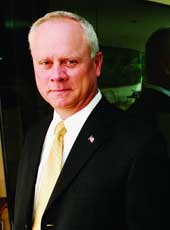Human capital: Top talent for the corner office

Finding C-level executives requires A-team approach.
Executive search firms have a lot in common with intelligence agencies. Their data collection is conducted in-depth and mostly in confidence, and their successes aren't known until the operation is over.But finding chief executive officers and other C-level positions ? chief operating officers, chief financial officers and chief technology officers, among others ? for government contractors is no different than finding outstanding corporate types to run Coca-Cola or Colgate-Palmolive, said Kevin McNerney, managing director and regional market leader of the global technology practice at Korn/Ferry International Inc., an executive search firm.It's always a quest to find the best candidates, he said. But when you're looking for top-level leadership, your client will be very demanding. "If a company is seeking a C-level executive, the recruiter's client is the board of directors, the CEO or maybe the president and chief operating officer," McNerney said.Though recruiting methods for all talent may be similar, search firm professionals say the focus is narrowed when they are looking for a C-level candidate. "You don't recruit someone from Proctor & Gamble for an IT company" because domain expertise is a major criterion in any C-level recruiting effort, said Robert Brudno, managing director of Savoy Partners, a boutique recruiting company in Washington.Brudno's recent recruiting efforts included helping hire Kenneth Dahlberg as Robert Beyster's successor as chairman and CEO at Science Applications International Corp. and getting Stanton Sloane to replace Renny DiPentima as president and CEO at SRA International Inc. He also helped convince Paul Cofoni to leave Computer Sciences Corp. to become president of U.S. operations at CACI International Inc.Brudno and McNerney agree, however, that industry expertise alone is not enough to place someone in a C-corridor office.Brudno said many people do contracting work for the government, but selling hardware to the Defense Department is different than systems integration or professional services consulting with a civilian agency. "The technology slash products slash services are important, too," he said. A top candidate must thoroughly know his industry, yet be versatile enough to adapt to new challenges.As an example Brudno cited the search for DiPentima's successor. "SRA came to us with a simple proposition," he said. "'Renny DiPentima wants to retire. Renny's done a terrific job, the company's doing great. We're not broken so we're not looking for a turn-around guy, we're looking for somebody who can keep us on this path,'" he said.Brudno said that because SRA's goal was to grow, "you're not just looking for a good person who could be a great CEO, you're looking for someone who brings DNA from markets you want to expand into."Knowing your client's goals is critical to knowing what type of person to recruit for the executive suite, said Paul Dinte, founder and CEO of Dinte Associates Inc., a search firm based in McLean, Va.When Sterling Phillips, chairman and CEO of Analex Corp. of Fairfax, Va., came to Dinte the goal was clear ? find people who can help the company grow. During an 18-month period, Dinte recruited a president, two vice presidents, a chief financial officer, a head of contracts and a head of human resources."In every instance, it was very important to find people with experience with large organizations," Dinte said. "Analex was a company that needed to grow, and it needed to attract the best and the brightest."The strategy worked. As Analex grew, it also attracted suitors and was acquired in March by QinetiQ Group plc for $173 million.It's a question of fit, said Evan Scott, president of the Evan Scott Group International, a retained executive search firm. "You could take somebody who's got great credentials and put them in Lockheed Martin and they'll fail because they don't understand how things are done at Lockheed Martin. On the other hand, you could take someone from Lockheed Martin, and put them in a smaller company, like a $30 million company, and they'll fail because they don't understand what it's truly like without all the resources and support systems that they're used to."That was not the case with Sloane, who was executive vice president of integrated systems and solutions at Lockheed Martin, a much larger company than SRA."To be honest, I was very happy where I was," Sloane said. "I wasn't looking to make a move." But because he'd always thought well of SRA, Sloane said he agreed to listen to Brudno's unsolicited pitch."Most of the better candidates are not unhappy, so there has to be a real opportunity. Having the opportunity to become a CEO is one of those inducements," Brudno said. "We never would have recruited Ken Dahlberg, who was No. 2 over at General Dynamics, to SAIC if he weren't going to be CEO right away as opposed to when [General Dynamics CEO] Nick Chabraja retired.""That clearly was [also] a motivation for Stan Sloane," Brudno added. "Stan was doing great things at Lockheed, but he was close in age to Bob Stevens, who's the CEO and is going to stay CEO at Lockheed Martin for a very, very long time."Brudno and Sloane spoke or met often for about six months, a period Sloane likened to a courtship, one that also included meetings and dinners with SRA Chairman Ernst Volgenau and DiPentima. Sloane said it was important for both sides to get to know each other well before either side could make a comfortable decision."If you're going into a new situation, you want to know what your ability is going to be to influence outcomes," Sloane explained. "You have to have confidence that you will have the resources, the flexibility and freedom of movement to make a difference."He said SRA's reputation and its growth plans were two key factors that persuaded him to accept the job. "All of the things looked like they were lining up to make this [proposition] very interesting," he said."People succeed or fail based solely on the cultural fit within the organization," Scott said. "And that's the most important ingredient that a good recruiter understands."Scott added that top-level executives don't move solely for money. "At the C-level, it's really the challenge, to make a mark and have an impact."Asked whether money was another key inducement, Sloane said, "I won't say the pay is irrelevant. Nobody is going to make a move that doesn't make sense financially. But it certainly wasn't the driver in my case."He said the long-term financial package is more of a fiscal inducement than salary for C-level appointments. "At least for me, and I would guess this is generally true, it's not so much about the near-term, it's what does the long-term hold? What is the potential?"Scott said executives will entertain a move "for the equity, the upside potential" down the road. Also, the opportunity to make decisions and effect change more rapidly is an inducement to move from a large company to a smaller one. CEOs "like to have control and to make decisions fast," he said."There are probably 10 to 12 core competencies that are relevant to the makeup of a successful candidate coming into those kinds of jobs," McNerney said.He believes the three top competencies for a CEO are solid, moral character; superb leadership skills from the board of directors to the most junior member of the company; and the ability to exercise good judgment whether the company is at the top of its game or in crisis.McNerney said a CEO must have exceptional communications skills ? the ability to speak to and be understood by Wall Street, the regulatory agencies, the federal government, the company and the public.The required communications skills for a CTO, on the other hand, will differ, he said. "It would be really important for this executive to have the ability to distill complicated, technical information and jargon and plans into very succinct, workable and understandable English."All recruiters agree that confidentiality is crucial. "Everything is kept low-key," Scott said. "There is always that risk, of course, as you get deeper into it that there could be a confidentiality breach, but remember, in today's world, everybody is responsible to manage their own career. No one is stunned to learn that one of their key executives might be looking or entertaining another opportunity. I find very few executives that won't take a recruiting call today."

Associate Editor David Hubler can be reached at dhubler@1105govinfo.

"If you're going into a new situation, you want to know what your ability is going to be to influence outcomes." Stan Sloane, SRA
Rick Steele
Associate Editor David Hubler can be reached at dhubler@1105govinfo.
NEXT STORY: Human capital: Show me more than the money

